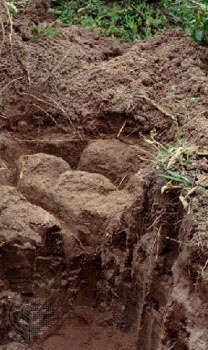Solonetz
FAO soil group
 one of the 30 soil groups in the classification system of the Food and Agriculture Organization (FAO) (soil). Solonetz soils are defined by an accumulation of sodium salts and readily displaceable sodium ions bound to soil particles in a layer below the surface horizon (uppermost layer). This subsurface layer also contains a significant amount of accumulated clay (clay mineral). Because of the high sodium content and dense, clay-rich subsoil, irrigated agriculture of these soils requires extensive reclamation—through leaching with fresh water and the construction of engineered drainage systems. Occupying about 1 percent of the continental land area on Earth (northeastern Argentina, Chile, and the coastal edges of every continent), Solonetz soils occur in dry climatic zones and on parent materials either naturally enriched in sodium-bearing minerals or influenced by saline waters.
one of the 30 soil groups in the classification system of the Food and Agriculture Organization (FAO) (soil). Solonetz soils are defined by an accumulation of sodium salts and readily displaceable sodium ions bound to soil particles in a layer below the surface horizon (uppermost layer). This subsurface layer also contains a significant amount of accumulated clay (clay mineral). Because of the high sodium content and dense, clay-rich subsoil, irrigated agriculture of these soils requires extensive reclamation—through leaching with fresh water and the construction of engineered drainage systems. Occupying about 1 percent of the continental land area on Earth (northeastern Argentina, Chile, and the coastal edges of every continent), Solonetz soils occur in dry climatic zones and on parent materials either naturally enriched in sodium-bearing minerals or influenced by saline waters.Solonetz soils are related to the sodium-accumulating Aridisols (Aridisol) and Mollisols (Mollisol) of the U.S. Soil Taxonomy. Because they do not require a warm climate in order to form, they can be found in association with both Solonchaks (Solonchak) and Kastanozems (Kastanozem), two FAO soil groups that form in warm and temperate climatic zones, respectively.
- Montpellier faience
- Montpellier I, II, and III, Universities of
- Montpensier, Anne-Marie-Louise d'Orléans, Duchess de
- Montreal
- Montreal Aquarium
- Montreal Botanical Garden
- Montreal group
- Montreal Museum of Fine Arts
- Montreuil
- Montreux
- Montrose
- Montrose, James Graham, 5th Earl and 1st Marquess of, Earl of Kincardine, Lord Graham and Mugdock
- Montrouge
- Montréal-Nord
- Mont Sainte-Anne
- Mont-Saint-Michel
- Montserrat
- Montserrat Caballé
- Montt, Manuel
- Montt, Pedro
- Monty Python's Flying Circus
- Montéclair, Michel de
- Montélimar
- Montúfar y Rivera Maestre, Lorenzo
- Monumenta Germaniae Historica